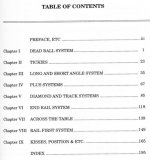There are numerous diamond and numbering systems. Has anyone ever seen or does anything exists which explains all of the different types in a book along with an explanation of the numbering for that system.
Not only are there systems for hitting an object ball on or close to a rail but there are numbering systems for hitting the object ball when it is a diamond or two out from the rail. Every once in awhile I'll stumble onto a system that I was unaware of and say to myself, "so that's how you do that".
It would really be nice if there was a resource that included all of these different types of systems , that exist, in one book.
Not only are there systems for hitting an object ball on or close to a rail but there are numbering systems for hitting the object ball when it is a diamond or two out from the rail. Every once in awhile I'll stumble onto a system that I was unaware of and say to myself, "so that's how you do that".
It would really be nice if there was a resource that included all of these different types of systems , that exist, in one book.
